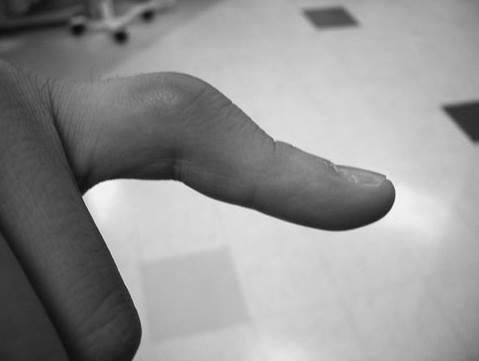A 29-year-old woman presents to the ED with a complaint of sudden onset of left facial weakness that was noticed by
her coworker. She denies fever, rash, or any other symptoms. On physical
examination, she has no other neurologic deficits other than what is shown . When asked to shut her left eye, she cannot. Which of the following is the most likely diagnosis?
A. Bell palsy
B. Malingering
C. Ramsay Hunt syndrome
D. Brain tumor
answer: A. Bells palsy.
The woman in the image demonstrates a Bell smile. Bell palsy is paralysis of the facial nerve and is one of the most common neuropathies of the cranial nerves. It typically occurs with abrupt onset, and is usually unilateral. Cranial nerve VII, the facial nerve, has 2 components, both of which may be affected. One portion comprises efferent fibers that stimulate the muscles of facial expression. The other portion contains taste fibers to the anterior two thirds of the tongue, and secretomotor fibers to the lacrimal and salivary glands. The path of the facial nerve is complex; which makes it vulnerable to injury. The definition of Bell palsy is mononeuropathy of the facial nerve, although other cranial nerves are sometimes affected. This paralysis is believed to be a result of inflammation of the nerve, possibly secondary to infection from Lyme or herpes zoster. Weakness and paralysis involves the entire face on the affected side. In supranuclear lesions (upper motor neuron) such as a cortical stroke, the upper third of the face is spared although the lower two thirds are paralyzed. This is because the orbicularis, frontalis, and corrugator muscles are innervated bilaterally. In addition, Bell palsy may cause decreased lacrimation, salivation, and decreased taste (ageusia). Treatment includes high-dose steroids in a short burst followed by tapering with lower doses. Treatment is most effective if administered within 48 hours. The addition of acyclovir may decrease resolution time. It is also important to have the patient tape his or her eyelid shut during sleep and to use liquid tears during the day to prevent drying and injury to the cornea. (B) Malingering is the intentional production of
false or exaggerated symptoms motivated by primary or secondary gain, such as to obtain compensation or drugs, to avoid work or military duty, or to evade criminal prosecution. (C) Acute facial paralysis that occurs in association with herpetic blisters of the skin of the ear canal, auricle, or both is referred to as Ramsay Hunt syndrome, or herpes zoster oticus. (D) Brain tumors typically cause central nervous system (CNS) defects. (E) Because a cerebrovascular event is centrally occurring, sparring of the upper third of the face is seen.
A. Bell palsy
B. Malingering
C. Ramsay Hunt syndrome
D. Brain tumor
answer: A. Bells palsy.
The woman in the image demonstrates a Bell smile. Bell palsy is paralysis of the facial nerve and is one of the most common neuropathies of the cranial nerves. It typically occurs with abrupt onset, and is usually unilateral. Cranial nerve VII, the facial nerve, has 2 components, both of which may be affected. One portion comprises efferent fibers that stimulate the muscles of facial expression. The other portion contains taste fibers to the anterior two thirds of the tongue, and secretomotor fibers to the lacrimal and salivary glands. The path of the facial nerve is complex; which makes it vulnerable to injury. The definition of Bell palsy is mononeuropathy of the facial nerve, although other cranial nerves are sometimes affected. This paralysis is believed to be a result of inflammation of the nerve, possibly secondary to infection from Lyme or herpes zoster. Weakness and paralysis involves the entire face on the affected side. In supranuclear lesions (upper motor neuron) such as a cortical stroke, the upper third of the face is spared although the lower two thirds are paralyzed. This is because the orbicularis, frontalis, and corrugator muscles are innervated bilaterally. In addition, Bell palsy may cause decreased lacrimation, salivation, and decreased taste (ageusia). Treatment includes high-dose steroids in a short burst followed by tapering with lower doses. Treatment is most effective if administered within 48 hours. The addition of acyclovir may decrease resolution time. It is also important to have the patient tape his or her eyelid shut during sleep and to use liquid tears during the day to prevent drying and injury to the cornea. (B) Malingering is the intentional production of
false or exaggerated symptoms motivated by primary or secondary gain, such as to obtain compensation or drugs, to avoid work or military duty, or to evade criminal prosecution. (C) Acute facial paralysis that occurs in association with herpetic blisters of the skin of the ear canal, auricle, or both is referred to as Ramsay Hunt syndrome, or herpes zoster oticus. (D) Brain tumors typically cause central nervous system (CNS) defects. (E) Because a cerebrovascular event is centrally occurring, sparring of the upper third of the face is seen.

